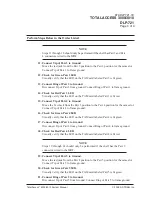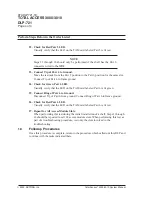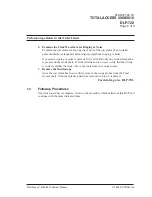
Total Access
®
3000/3010 System Manual
6TADLP725-1E
TOTAL ACCESS 3000/3010
DLP-725
Page 1 of 4
© 2002, ADTRAN, Inc.
Perform Steps Below in the Order Listed
1.1
Verifying Intershelf Communication
NOTE
References to common, but differing, parameters between the Total Access
3000 and the Total Access 3010, such as number of slots, will be conveyed
by the convention a/b. The “a” represents the Total Access 3000 parameter
and the “b” represents the Total Access 3010 parameter. For example, the
differing number of access slots in the two platforms, 28 for the Total Access
3000 and 22 for the Total Access 3010, would be displayed “28/22.”
1.1.1
Introduction
This procedure details the test steps which must be performed if two or more Total
Access 3000/3010 shelves are connected together via the RS-485 bus to allow
intershelf communication. This procedure verifies that the Host SCU can properly
communicate with all Client SCUs connected on the RS-485 bus.
1.1.2
Prerequisite Procedures
Before beginning this procedure, you should have completed the installation tasks
detailed in DLP-712. For intershelf communication to succeed, you must have
properly configured the Target ID (TID) and Shelf Number in each SCU and must
have enabled the RS-485 interface on each SCU. In addition, one SCU must be
configured for Host Mode while all other SCUs must be configured in Client Mode.
1.1.3
Tools and Materials Required
• VT100 Terminal or PC with VT100 Terminal Emulation software
WARNING
To prevent electrical shock, do not install equipment in a wet location or
during a lightning storm.
CAUTION
Electronic modules can be damaged by static electrical discharge. Before
handling modules, wear an antistatic discharge wrist strap to prevent damage
to electronic components. Place modules in antistatic packing material when
transporting or storing. When working on modules, always place them on an
approved antistatic mat that is electrically grounded.
















































